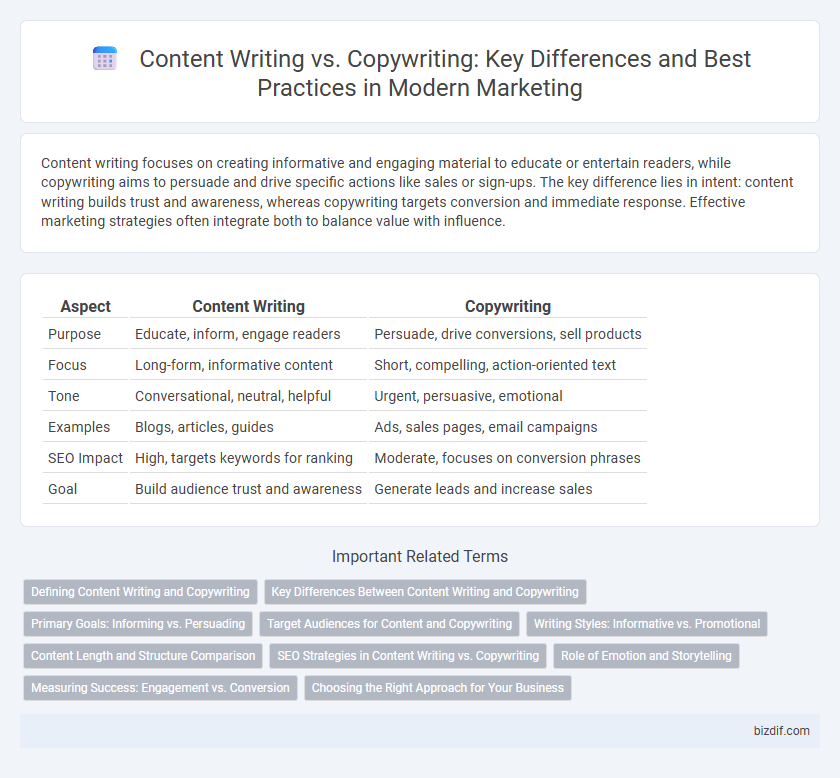Content writing focuses on creating informative and engaging material to educate or entertain readers, while copywriting aims to persuade and drive specific actions like sales or sign-ups. The key difference lies in intent: content writing builds trust and awareness, whereas copywriting targets conversion and immediate response. Effective marketing strategies often integrate both to balance value with influence.
Table of Comparison
| Aspect | Content Writing | Copywriting |
|---|---|---|
| Purpose | Educate, inform, engage readers | Persuade, drive conversions, sell products |
| Focus | Long-form, informative content | Short, compelling, action-oriented text |
| Tone | Conversational, neutral, helpful | Urgent, persuasive, emotional |
| Examples | Blogs, articles, guides | Ads, sales pages, email campaigns |
| SEO Impact | High, targets keywords for ranking | Moderate, focuses on conversion phrases |
| Goal | Build audience trust and awareness | Generate leads and increase sales |
Defining Content Writing and Copywriting
Content writing involves creating informative, engaging, and valuable text aimed at educating or entertaining an audience, often found in blogs, articles, and social media posts. Copywriting focuses on persuasive language designed to drive specific actions such as sales, subscriptions, or inquiries through advertisements, landing pages, and email campaigns. Both disciplines require an understanding of audience needs but differ primarily in purpose, with content writing emphasizing information and copywriting prioritizing conversion.
Key Differences Between Content Writing and Copywriting
Content writing focuses on creating informative, engaging, and valuable material such as blog posts, articles, and guides aimed at educating or entertaining the audience. Copywriting centers on persuasive, concise, and action-driven text designed to convert readers into customers or prompt immediate responses. The key differences lie in intent, style, and measurable outcomes, with content writing prioritizing long-term audience engagement and copywriting driving direct marketing results.
Primary Goals: Informing vs. Persuading
Content writing primarily aims to inform and educate the audience by providing valuable and relevant information, enhancing brand authority and trust. Copywriting focuses on persuasion, crafting compelling messages that drive reader action such as purchasing, subscribing, or clicking. Effective marketing strategies often integrate both by using informative content to build credibility and persuasive copy to convert leads into customers.
Target Audiences for Content and Copywriting
Content writing focuses on engaging and informing a broader audience by providing valuable, relevant information to build trust and long-term relationships. Copywriting targets specific customer segments with persuasive language aimed at driving immediate actions such as purchases, sign-ups, or clicks. Understanding the distinct goals and behaviors of these target audiences enables marketers to tailor messages effectively for optimal engagement and conversion rates.
Writing Styles: Informative vs. Promotional
Content writing employs an informative style aimed at educating and engaging readers by providing valuable, relevant information that builds trust and authority. Copywriting utilizes a promotional style focused on persuasive language designed to drive conversions and prompt immediate action from the audience. Understanding these distinct writing styles is essential for crafting messages that either inform or influence effectively within marketing strategies.
Content Length and Structure Comparison
Content writing typically involves longer, well-structured pieces designed to inform, educate, or engage readers through detailed explanations, often exceeding 1,000 words. Copywriting focuses on concise, persuasive text structured around clear calls-to-action, usually contained within 100 to 300 words to maximize impact. The structure of content writing prioritizes headings, subheadings, and comprehensive paragraphs, whereas copywriting employs attention-grabbing headlines and brief, impactful sentences to drive conversions.
SEO Strategies in Content Writing vs. Copywriting
Content writing focuses on delivering informative, keyword-rich articles that enhance organic search rankings and drive sustained traffic through SEO strategies like keyword research, on-page optimization, and quality backlinks. Copywriting prioritizes persuasive language designed to boost conversions and engagement, often incorporating targeted keywords to support short-term marketing goals within search campaigns. Both disciplines leverage SEO tactics but differ in intent: content writing aims for visibility and authority, while copywriting targets immediate action and brand messaging impact.
Role of Emotion and Storytelling
Content writing leverages emotion and storytelling to build trust and engage audiences by providing valuable, informative narratives that resonate deeply with readers' experiences and needs. Copywriting strategically harnesses emotional triggers and compelling stories to drive immediate action, persuasion, and conversion through concise, impactful messages. Both disciplines utilize emotional appeal and storytelling, but content writing fosters long-term relationships while copywriting focuses on prompt response.
Measuring Success: Engagement vs. Conversion
Content writing measures success primarily through engagement metrics such as time on page, social shares, and comments, which indicate audience interest and value. Copywriting, however, focuses on conversion rates, tracking actions like click-throughs, sign-ups, and sales to evaluate effectiveness. Understanding these distinct KPIs helps businesses tailor strategies to either build relationships or drive immediate customer actions.
Choosing the Right Approach for Your Business
Content writing focuses on providing valuable, informative, and engaging material to build trust and authority in your industry, while copywriting aims to persuade and drive immediate action through compelling calls-to-action and targeted messaging. Selecting the right approach depends on your business goals: content writing nurtures long-term relationships and improves SEO, whereas copywriting boosts conversions and sales in the short term. Combining both strategies creates a balanced marketing approach that enhances brand awareness while maximizing customer acquisition.
Content Writing vs Copywriting Infographic

 bizdif.com
bizdif.com